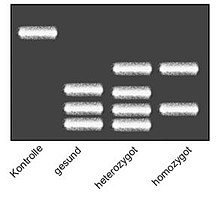User:Amorack/sandbox
Applications[edit]
Variations in the sequence of DNA such as SNPs can affect the progression of diseases and individual responses to pathogens, chemicals, drugs, vaccines, and other agents. Consequently, the study of SNPs is critical for personalized medicine.[1] More generally, applications of the study of SNPs include biomedical research, forensics, pharmacogenetics, and disease causation. Genetic association studies can determine whether a genetic variant is associated with a particular disease or trait.[2]

Linkage disequilibrium (LD), a term used in population genetics, indicates non-random association of alleles at two or more loci, not necessarily on the same chromosome. It refers to the phenomenon that SNPs or other DNA sequences that are close together in the genome tend to be inherited together. LD can be affected by two parameters (among other factors, such as population stratification): 1) The distance between the SNPs, where a larger distance lowers the LD, and 2) Recombination rate, with a lower recombination rate leading to a higher LD.[3] A "tag SNP" is a representative SNP in a region of the genome with high LD, and these tag SNPs are useful in whole-genome SNP association studies which examine hundreds of thousands of SNPs across the entire genome. In haplotype mapping, sets of alleles or DNA sequences can be clustered so that a single SNP can identify many linked SNPs. In genetic epidemiology, SNPs are used to estimate transmission clusters.[4]
Examples[edit]
- rs6311 and rs6313 are SNPs in the Serotonin 5-HT2A receptor gene on human chromosome 13.[5]
- The SNP − 3279C/A (rs3761548) is amongst the SNPs locating in the promoter region of the Foxp3 gene, might be involved in cancer progression.[6]
- A SNP in the F5 gene causes Factor V Leiden thrombophilia.[7]

PCR and gel electrophoresis being used to diagnose Factor V Leiden thrombophilia. - rs3091244 is an example of a triallelic SNP in the CRP gene on human chromosome 1.[8]
- TAS2R38 codes for PTC tasting ability, and contains 6 annotated SNPs.[9]
- rs148649884 and rs138055828 in the FCN1 gene encoding M-ficolin crippled the ligand-binding capability of the recombinant M-ficolin.[10]
- An intronic SNP in DNA mismatch repair gene PMS2 (rs1059060, Ser775Asn) is associated with increased sperm DNA damage and risk of male infertility.[11]
- ^ Carlson, Bruce (15 June 2008). "SNPs — A Shortcut to Personalized Medicine". Genetic Engineering & Biotechnology News. 28 (12). Mary Ann Liebert, Inc. Archived from the original on 26 December 2010. Retrieved 2008-07-06.
(subtitle) Medical applications are where the market's growth is expected
- ^ Zhang K, Qin ZS, Liu JS, Chen T, Waterman MS, Sun F (May 2004). "Haplotype block partitioning and tag SNP selection using genotype data and their applications to association studies". Genome Research. 14 (5): 908–16. doi:10.1101/gr.1837404. PMC 479119. PMID 15078859.
- ^ Gupta PK, Roy JK, Prasad M (25 February 2001). "Single nucleotide polymorphisms: a new paradigm for molecular marker technology and DNA polymorphism detection with emphasis on their use in plants". Current Science. 80 (4): 524–535. Archived from the original on 13 February 2017.
- ^ Stimson J, Gardy J, Mathema B, Crudu V, Cohen T, Colijn C (25 January 2019). "Beyond the SNP Threshold: Identifying Outbreak Clusters Using Inferred Transmissions". Molecular Biology and Evolution. 36 (3): 587–603. doi:10.1093/molbev/msy242. PMC 6389316. PMID 30690464.
- ^ Giegling I, Hartmann AM, Möller HJ, Rujescu D (November 2006). "Anger- and aggression-related traits are associated with polymorphisms in the 5-HT-2A gene". Journal of Affective Disorders. 96 (1–2): 75–81. doi:10.1016/j.jad.2006.05.016. PMID 16814396.
- ^ Ezzeddini R, Somi MH, Taghikhani M, Moaddab SY, Masnadi Shirazi K, Shirmohammadi M, Eftekharsadat AT, Sadighi Moghaddam B, Salek Farrokhi A (February 2021). "Association of Foxp3 rs3761548 polymorphism with cytokines concentration in gastric adenocarcinoma patients". Cytokine. 138: 155351. doi:10.1016/j.cyto.2020.155351. ISSN 1043-4666. PMID 33127257. S2CID 226218796.
- ^ Kujovich JL (January 2011). "Factor V Leiden thrombophilia". Genetics in Medicine. 13 (1): 1–16. doi:10.1097/GIM.0b013e3181faa0f2. PMID 21116184.
- ^ Morita A, Nakayama T, Doba N, Hinohara S, Mizutani T, Soma M (June 2007). "Genotyping of triallelic SNPs using TaqMan PCR". Molecular and Cellular Probes. 21 (3): 171–6. doi:10.1016/j.mcp.2006.10.005. PMID 17161935.
- ^ Prodi DA, Drayna D, Forabosco P, Palmas MA, Maestrale GB, Piras D, Pirastu M, Angius A (October 2004). "Bitter taste study in a sardinian genetic isolate supports the association of phenylthiocarbamide sensitivity to the TAS2R38 bitter receptor gene". Chemical Senses. 29 (8): 697–702. doi:10.1093/chemse/bjh074. PMID 15466815.
- ^ Ammitzbøll CG, Kjær TR, Steffensen R, Stengaard-Pedersen K, Nielsen HJ, Thiel S, Bøgsted M, Jensenius JC (28 November 2012). "Non-synonymous polymorphisms in the FCN1 gene determine ligand-binding ability and serum levels of M-ficolin". PLOS ONE. 7 (11): e50585. Bibcode:2012PLoSO...750585A. doi:10.1371/journal.pone.0050585. PMC 3509001. PMID 23209787.
- ^ Ji G, Long Y, Zhou Y, Huang C, Gu A, Wang X (May 2012). "Common variants in mismatch repair genes associated with increased risk of sperm DNA damage and male infertility". BMC Medicine. 10: 49. doi:10.1186/1741-7015-10-49. PMC 3378460. PMID 22594646.


